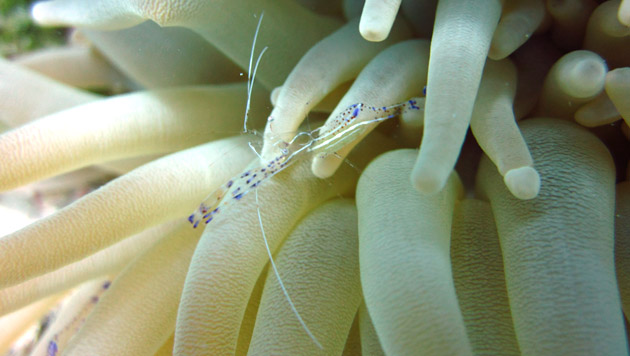Posted in:
Understanding the Unique Relationship Between Crustaceans and Sea Anemones

When most people think about sea anemones they usually think of clownfish as well—the small orange, black, and white fish that make their homes within the sea anemones’ tentacles. Anemones and clownfish have a symbiotic relationship known as “mutualism,” in which each species benefits the other. Able to withstand an anemone’s stinging tentacles, the clownfish use the anemones for protection from predators. In return, the clownfish clean the anemones of parasites, provide a source of nitrogen for growth and regeneration, and even help circulate the water around the anemones. While this is one of the most recognizable forms of mutualism in the ocean, sea anemones also have symbiotic relationships with a variety of crustaceans.
Ben Titus, a 2nd year PhD student at The Ohio State University working under Dr. Meg Daly, and Eric Witt, an undergraduate student at Otterbein University (Columbus, OH) recently visited Bermuda to study four species of local crustaceans in an effort to shed light on how biodiversity evolves within such symbiotic relationships. Titus and Witt looked at the corkscrew anemone (Bartholomea annulata) and four common crustaceans, each of which interact with, and depend upon, the anemone in a different way. The red snapping shrimp (Genus Alpheus), most often found buried in the sand beneath the anemone’s column, is considered an obligate symbiont, meaning that it depends upon the anemone for survival. The Pederson cleaning shrimp (Genus Ancylomenes) is commonly found within the anemone’s tentacles; it, too, is an obligate symbiont, but it is also considered a host generalist, which means it will associate with a variety of anemone species. The sexy shrimp (Genus Thor) is a generalist symbiont found with a variety of anemones and corals. Finally, the arrow crab (Genus Stenorhynchus) is loosely in contact with the anemone—usually found on the sand around the anemone—and is considered a facultative symbiont, which means it often lives in association with an anemone, but that such a relationship isn’t necessary for its survival.
Titus’ research focuses on how variation within the crustacean lifestyle (that is, their type and level of host specificity) impacts their genetic structure over fine or large scales. For example, do obligate symbionts have more limited gene flow between populations than facultative symbionts? Asked about the significance of his research, Titus points out that, “Engaging in a symbiosis has major biological ramifications for dispersal ability and reproductive opportunities. Coral reefs as a system, achieve their success from these complex, multi-level symbioses, and understanding the factors that generate biodiversity within symbioses will allow us to understand these remarkable systems at a deeper level.”
Over a two-year period, Titus has traveled to Honduras, the Florida Keys, Bermuda, and St. Thomas/USVI, and has planned trips to Mexico, Cuba, and Curacao/Bonaire to collect tentacle clippings from anemones, as well as individual samples of the four species of shrimp and crabs mentioned above. Using genetic extraction, a process called polymerase chain reaction—or PCR—and Next Generation Sequencing, Titus will be able to sequence the anemones’ and crustaceans’ DNA at thousands of loci (locations) to determine how the populations are genetically structured, what the gene flow is like between different populations, and what—if any—correlation there is between genetic diversity and host specificity.
Witt is working with Titus for his undergraduate thesis research, and is interested in just one of these crustaceans: the Pederson cleaning shrimp. Until recently, there were thought to be two separate species of Pederson’s cleaning shrimp based upon slight morphological (physical) differences, with one species found in Florida and the Caribbean and the other in Bermuda. Scientists hypothesized the shrimp underwent a “host shift” in Bermuda, relying only on the giant Caribbean sea anemone (Condylactis gigantea), whereas it relies on multiple species of anemones in the Caribbean. However, Witt and Titus observed Pederson cleaning shrimp on this anemone, as well as the corkscrew anemone (Bartholomea annulata) and the branching anemone (Lebrunia danae), leading them to believe there may be a single species after all. For his part, Witt is conducting a species delimitation study that will answer the question of how far apart, genetically speaking, the Caribbean and Bermuda shrimp populations actually are. Using the same techniques as Titus, Witt will also be able to establish the historical gene flow between these two populations.
Answers to questions such as these have potential implications for the evolution of new species resulting from genetic isolation. At the same time, understanding the genetic structure of these crustacean populations is important for two very different reasons. First, the crustaceans play an important role in the marine ecosystem, acting as cleaning stations for fish, providing nitrogen and other nutrients to the anemones, and even protecting the anemones from predatory fish and worms. Second, these shrimp are collected for the aquarium trade, and information about their populations can help managers make better-informed decisions to help conserve wild populations.
Tagged: